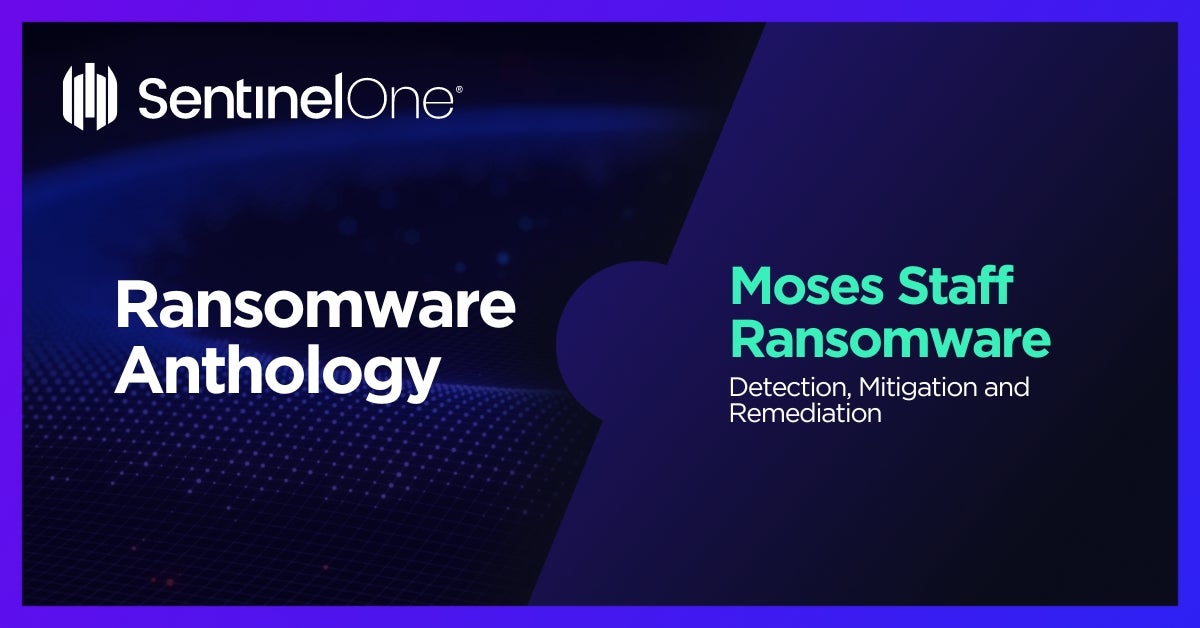Moses Staff Ransomware: In-Depth Analysis, Detection, and Mitigation
What is Moses Staff Ransomware?
Moses Staff, emerging in late 2021, is a politically driven cyber threat group with roots in Iran. This ransomware stands out for its multifaceted extortion approach, use of custom-built tools, and exploitation of known vulnerabilities like ProxyShell. Notably, they actively use social media platforms like Twitter and Telegram to update and publicly shame their victims, showcasing a unique blend of technical and psychological warfare.

What Does Moses Staff Ransomware Target?
Moses Staff has a specific focus on sectors crucial to societal functioning – government, healthcare, engineering, and finance. Indicative of geo-specific intentions, their initial onslaught in 2021 predominantly targeted Israeli entities, revealing a strategic approach to cyber warfare.
How Does Moses Staff Ransomware Work?
Employing third-party frameworks (e.g., Vatet Loader, Metasploit, Cobalt Strike), Moses Staff capitalizes on vulnerabilities like ProxyShell (CVE-2021-31207, CVE-2021-34473, CVE-2021-34523) to infiltrate networks. Their sophisticated approach involves using custom backdoors and webshells, enhancing their ability to navigate laterally within networks, deliver ransomware payloads, and execute them effectively.
Moses Staff Ransomware Technical Details
The attackers have been known to utilize ProxyShell exploits to gain their foothold in the targeted environment. Custom backdoors and webshells have also been leveraged by the Moses Staff operators. The custom backdoor tool provides RAT-like features and functionality, further easing the process of lateral discovery, ransomware payload delivery, and subsequent execution.
How to Detect Moses Staff Ransomware
The SentinelOne Singularity XDR Platform detects and prevents malicious behaviors and artifacts associated with Moses Staff ransomware.
If you do not have SentinelOne deployed, here are a few ways you can identify Moses Staff ransomware in your network:
Security Tools
Use anti-malware software or other security tools capable of detecting and blocking known ransomware variants. These tools may use signatures, heuristics, or machine learning algorithms, to identify and block suspicious files or activities.
Network Traffic
Monitor network traffic and look for indicators of compromise, such as unusual network traffic patterns or communication with known command-and-control servers.
Security Audits
Conduct regular security audits and assessments to identify network and system vulnerabilities and ensure that all security controls are in place and functioning properly.
Education & Training
Educate and train employees on cybersecurity best practices, including identifying and reporting suspicious emails or other threats.
Backup & Recovery Plan
Implement a robust backup and recovery plan to ensure that the organization has a copy of its data and can restore it in case of an attack.
How to Mitigate Moses Staff Ransomware
SentinelOne Singularity XDR Platform prevents Moses Staff ransomware infections. In case of an infection, the SentinelOne Singularity XDR Platform detects and prevents malicious behaviors and artifacts associated with Moses Staff ransomware.
SentinelOne customers are protected from Moses Staff ransomware without any need to update or take action. In cases where the policy was set to Detect Only and a device became infected, remove the infection by using SentinelOne’s unique rollback capability. As the accompanying video shows, the rollback will revert any malicious impact on the device and restore encrypted files to their original state.
In case you do not have SentinelOne deployed, there are several steps that organizations can take to mitigate the risk of Moses Staff ransomware attacks:
Educate employees
Employees should be educated on the risks of ransomware, and how to identify and avoid phishing emails, malicious attachments, and other threats. They should be encouraged to report suspicious emails or attachments, and to avoid opening them, or clicking on links or buttons in them.
Implement strong passwords
Organizations should implement strong, unique passwords for all user accounts, and should regularly update and rotate these passwords. Passwords should be at least 8 characters long and should include a combination of uppercase and lowercase letters, numbers, and special characters.
Enable multi-factor authentication
Organizations should enable multi-factor authentication (MFA) for all user accounts, to provide an additional layer of security. This can be done through the use of mobile apps, such as Google Authenticator or Microsoft Authenticator, or the use of physical tokens or smart cards.
Update and patch systems
Organizations should regularly update and patch their systems, to fix any known vulnerabilities, and to prevent attackers from exploiting them. This includes updating the operating system, applications, and firmware on all devices, as well as disabling any unnecessary or unused services or protocols.
Implement backup and disaster recovery
Organizations should implement regular backup and disaster recovery (BDR) processes, to ensure that they can recover from ransomware attacks or other disasters. This includes creating regular backups of all data and systems and storing these backups in a secure, offsite location. The backups should be tested regularly to ensure that they are working and that they can be restored quickly and easily.